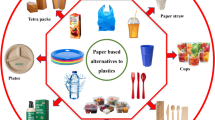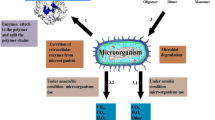Abstract
Paper is still regarded as the most common carrier of information. Encouraged by environmental policies, the papermaking technology recently changed, resulting in an increased production of recycled paper. Two types of contemporary paper, non-recycled and recycled, were thus investigated to evaluate possible differences in their rate of degradation. The analyses were carried out using unaged paper to evaluate acidity, dry matter and ash content, lignin presence, and fibre furnish. Accelerated ageing experiments were performed at different temperatures (50–80 °C) and water vapour pressures (90.5–227.5 torr). Viscometric measurements were carried out to evaluate the extent of paper degradation as a function of time, upon various accelerated ageing conditions. The results indicate that the rates of degradation follow first-order kinetics with respect to scission of glycosidic bonds, the rate constants for recycled paper being found to be slightly higher than the corresponding constants for non-recycled paper, but comparable within experimental limits. The kinetic constants did not display a monotonic trend with increasing water vapour pressures. The Arrhenius dependence of the rate constants on temperature for both kinds of paper supplied the activation energies, which fall in the typical range expected for paper degradation. Finally, the measured rate constants fit fairly well the recently modelled dose–response function for historic paper. Colour changes were found to be visible to the human eye for samples aged for more than 40 days at 60, 70 and 80 °C.
Graphical abstract








Similar content being viewed by others
References
Area MC, Cheradame H (2011) Paper aging and degradation: recent findings and research methods. BioResources 6:5307–5337. https://doi.org/10.15376/biores.6.4.5307-5337
Ashley-Smith J, Derbyshire A, Pretzel B (2002) The continuing development of a practical lighting policy for works of art on paper and other object types at the Victoria and Albert Museum, in 13th triennial meeting ICOM Committee for conservation. Rio de Janeiro I:3–8
Barański A, Konieczna-Molenda A, Łagan J, Proniewicz L (2003) Catastrophic room temperature degradation of cotton cellulose. Restaurator 24:36–45. https://doi.org/10.1515/REST.2003.36
Barański A, Łagan JM, Łojewski T (2005) Acid-catalysed degradation. In: Strlič M, Kolar J (eds) Ageing and stabilisation of paper. National and University Library, Ljubljana, pp 85–100
Bicchieri M, Monti M, Piantanida G, Sodo A (2016) Effects of gamma irradiation on deteriorated paper. Radiat Phys Chem 125:21–26. https://doi.org/10.1016/j.radphyschem.2016.03.005
Čabalová I, Kačík F, Gojný J, Češek B, Milichovský M, Mikala O, Tribulová T, Ďurkovič J (2017) Changes in the chemical and physical properties of paper documents due to natural ageing. BioResources 12:2618–2634. https://doi.org/10.15376/biores.12.2.2618-2634
Castro K, Princi E, Proietti N, Manso M, Capitani D, Vicini S, Madariaga JM, De Carvalho ML (2011) Assessment of the weathering effects on cellulose based materials through a multianalytical approach. Nucl Instrum Methods Phys Res B 269:1401–1410. https://doi.org/10.1016/j.nimb.2011.03.027
Dupont A-L, Mortha G (2004) Comparative evaluation of size-exclusion chromatography and viscometry for the characterisation of cellulose. J Chromatogr A 1026:129–141. https://doi.org/10.1016/j.chroma.2003.11.002
Ekenstam A (1936) Über das Verhalten der Cellulose in Mineralsäure-lösungen, II. Mitteil: kinetisches Studium des abbaus der Cellulose in Säure-lösungen. Ber Dtsch Chem Ges 69:553–559
Emsley AM, Stevens GC (1994) Kinetics and mechanisms of the low-temperature degradation of cellulose. Cellulose 1:26–56. https://doi.org/10.1007/BF00818797
Emsley AM, Ali M, Heywood RJ (2000) A size exclusion chromatography study of cellulose degradation. Polymer 41:8513–8521. https://doi.org/10.1016/S0032-3861(00)00243-3
Evans R, Wallis A (1987) Comparison of cellulose molecular weights determined by high performance size exclusion chromatography and viscometry. In: Fourth international symposium on wood and pulping chemistry, Paris
Fedrigoni (2018a) http://www.fedrigoni.co.uk/papers/arcoprint-1-ew. Accessed 24 Jan 2018
Fedrigoni (2018b) http://www.fedrigoni.co.uk/papers/woodstock. Accessed 24 Jan 2018
Flory P (1953) Principles of polymer chemistry. Cornell University Press, Ithaca, pp 266–316
Forney CF, Brandl DG (1992) Control of humidity in small controlled-environment chambers using glycerol–water solutions. HortTechnology 2:52–54
Glycerine Producers’ Association (1963) Physical properties of glycerine and its solutions. Glycerine Producers’ Association, London
Hardeberg JY (2001) Acquisition and reproduction of colour images: colourimetric and multispectral approaches. Dissertation.com, USA
Hart PW, Santos RB (2013) Kraft ECF pulp bleaching: a review of the development and use of techno-economic models to optimize cost performance and justify capital expenditures. Tappi J 12:19–29
Ilvessalo-Pfäffli M (1995) Fiber atlas: identification of papermaking fibers. Springer, Berlin
ISO 9184-3 (1990) Paper, board and pulps—Fibre furnish analysis—Part 3: Herzberg staining test
ISO 5351 (2010) Pulps—determination of limiting viscosity number in cupriethylenediamine (CED) solution
ISO 5631-2 (2015) Paper and board—determination of colour by diffuse reflectance—part 2: outdoor daylight conditions (D65/10°)
ISO 2144 (2015) Paper, board and pulps—Determination of residue (ash) on ignition at 900 °C
ISO/CIE 11664-6 (2014) Colorimetry—Part 6: CIEDE2000 colour-difference formula
Kačík F, Kačíková D, Jablonský M, Katuščák S (2009) Cellulose degradation in newsprint paper ageing. Polym Degrad Stabil 94:1509–1514. https://doi.org/10.1016/j.polymdegradstab.2009.04.033
Kočar D, Strlič M, Kolar J, Rychlý J, Matisová-Rychlá L, Pihlar B (2005) Chemiluminescence from paper III: the effect of superoxide anion and water. Polym Degrad Stabil 88:407–414. https://doi.org/10.1016/j.polymdegradstab.2004.12.005
Liu Y, Kralj Cigić I, Strlič M (2017) Kinetics of accelerated degradation of historic iron gall ink-containing paper. Polym Degrad Stabil 42:255–262. https://doi.org/10.1016/j.polymdegradstab.2017.07.010
Łojewski T, Zięba K, Knapik A, Bagniuk J, Lubańska A, Łojewska J (2010a) Evaluating paper degradation progress. Cross-linking between chromatographic, spectroscopic and chemical results. Appl Phys A 100:809–821. https://doi.org/10.1007/s00339-010-5657-5
Łojewski T, Zięba K, Łojewska J (2010b) Size exclusion chromatography and viscometry in paper degradation studies. New Mark–Houwink coefficients for cellulose in cupri-ethylenediamine. J Chromatogr A 1217:6462–6468. https://doi.org/10.1016/j.chroma.2010.07.071
Łojewski T, Zięba K, Kołodziej A, Łojewska J (2011) Following cellulose depolymerization in paper: comparison of size exclusion chromatography techniques. Cellulose 18:1349–1363. https://doi.org/10.1007/s10570-011-9562-7
Mahy M, Eycken L, Oosterlinck A (1994) Evaluation of uniform color spaces developed after the adoption of CIELAB and CIELUV. Color Res Appl 19:105–121. https://doi.org/10.1111/j.1520-6378.1994.tb00070.x
Menart E, de Bruin G, Strlič M (2011) Dose-response functions for historic paper. Polym Degrad Stabil 96:2029–2039. https://doi.org/10.1016/j.polymdegradstab.2011.09.002
Mosca Conte A, Pulci O, Knapik A, Bagniuk J, Del Sole R, Łojewska J, Missori M (2012) Role of cellulose oxidation in the yellowing of ancient paper. Phys Rev Lett 108:158301/1-5. https://doi.org/10.1103/PhysRevLett.108.158301
Nevell TP, Zeronian SH (1985) Cellulose chemistry and its applications. Ellis Hordwood Ltd, Chichester
Paltakari JT, Karlsson MA (1996) Determination of specific heat for dry fibre material. In: 82nd annual meeting, technical section, CPPA, pp B117–B120
Porck HJ (2000) Rate of paper degradation—the predictive value of artificial aging tests. European Commission on Preservation and Access, Amsterdam
Roberts JC (1996) The chemistry of paper. Royal Society of Chemistry, Cambridge
Rouchon V, Belhad O, Duranto M, Gimat A, Massiani P (2016) Application of Arrhenius law to DP and zero-span tensile strength measurements taken on iron gall ink impregnated papers: relevance of artificial ageing protocols. Appl Phys A 122:773/1-10. https://doi.org/10.1007/s00339-016-0307-1
Seth RS (1990) Fibre quality factors in papermaking. In: Caulfield DF, Passaretti JD, Sobczynski SF (eds) Material interactions relevant to the pulp, paper and wood industries. Materials Research Society, San Francisco, pp 125–142
Sharma G, Wu W, Dalal EN (2005a) Supplemental test data and excel and matlab implementations of the CIEDE2000 color difference formula. http://www2.ece.rochester.edu/~gsharma/ciede2000/. Accessed 5 June 2018
Sharma G, Wu W, Dalal EN (2005b) The CIEDE2000 color-difference formula: implementation notes, supplementary test data, and mathematical observations. Color Res Appl 30:21–30. https://doi.org/10.1002/col.20070
Strang T, Grattan D (2009) Temperature and Humidity considerations for the preservation of organic collections—the isoperm revisited. e-Preservation Science 6:122–128
Strlič M, Kolar J (2003) Size exclusion chromatography of cellulose in LiCl/N, N-dimethylacetamide. J Biochem Biophys Methods 56:265–279. https://doi.org/10.1016/S0165-022X(03)00064-2
Strlič M, Kolar J, Žigon M, Pihlar B (1998) Evaluation of size-exclusion chromatography and viscometry for the determination of molecular masses of oxidised cellulose. J Chromatogr A 805:93–99. https://doi.org/10.1016/S0021-9673(98)00008-9
Strlič M, Kolar J, Kočar D, Drnovšek T, Šelih VS, Susič R, Pihlar B (2004) What is the pH of alkaline paper? e-Preservation Science 1:35–47
Strlič M, Kolar J, Scholten S (2005a) Paper and durability. In: Strlič M, Kolar J (eds) Ageing and stabilisation of paper. National and University Library, Ljubljana, pp 3–8
Strlič M, Kolar J, Scholten S (2005b) Methodology and analytical techniques in paper stability studies. In: Strlič M, Kolar J (eds) Ageing and stabilisation of paper. National and University Library, Ljubljana, pp 25–44
Strlič M, Kralj Cigić I, Kolar J, De Bruin G, Pihlar B (2007) Non-destructive evaluation of historical paper based on pH estimation from VOC emissions. Sensors 7:3136–3145. https://doi.org/10.3390/s7123136
Strlič M, Kralj Cigić I, Možir A, De Bruin G, Kolar J, Cassar M (2011) The effect of volatile organic compounds and hypoxia on paper degradation. Polym Degrad Stabil 96:608–615. https://doi.org/10.1016/j.polymdegradstab.2010.12.017
Strlič M, Grossi CM, Dillon C, Bell N, Fouseki K, Brimblecombe P, Menart E, Ntanos K, Lindsay W, Thickett D, France F, De Bruin G (2015) Damage function for historic paper. Part III: isochrones and demography of collections. Heritage Science 3:40. https://doi.org/10.1186/s40494-015-0069-7
TAPPI T 401 om-82 (1982) Test method: fiber analysis of paper and paperboard
Tanford C (1961) Physical chemistry of macromolecules. Wiley, NY, pp 390–412
Zervos S (2010) Natural and accelerated ageing of cellulose and paper: a literature review. In: Lejeune A, Deprez T (eds) Cellulose: structure and properties, derivatives and industrial uses. Nova Science Publishers, New York, pp 155–203
Zou X, Uesaka T, Gurnagul N (1996) Prediction of paper permanence by accelerated aging I. Kinetic analysis of the aging process. Cellulose 3:243–267. https://doi.org/10.1007/BF02228805
Acknowledgments
The authors thank the Italian Ministero dell’Istruzione, dell’Università e della Ricerca for financial support. Thanks are due to Dr. Irena Kralj Cigić (University of Ljubljana) for ash content measurements.
Author information
Authors and Affiliations
Corresponding author
Rights and permissions
About this article
Cite this article
Coppola, F., Modelli, A., Strlič, M. et al. Kinetics of degradation of non-recycled and recycled contemporary paper. Cellulose 25, 5337–5347 (2018). https://doi.org/10.1007/s10570-018-1951-8
Received:
Accepted:
Published:
Issue Date:
DOI: https://doi.org/10.1007/s10570-018-1951-8




